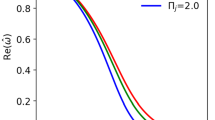Abstract
Thermal instability (TI) is a trigger mechanism, which can explain formation of condensations through some regions of the interstellar clouds. Our goal here is to investigate some conditions for occurrence of TI and formation of pre-condensations through the outer half a quasi-static spherical molecular clump or core. The inner half is nearly singular and ambiguous so out of scope of this research. We consider a spherically symmetric molecular cloud in quasi-static and thermally equilibrium state, and we use the linear perturbation method to investigate occurrence of TI through its outer half. The origin of perturbations are assumed to be as Inside-Rush-Perturbation (IRP) with outward perturbed velocity at inner region of the cloud, and Outside-Rush-Perturbation (ORP) with inward perturbed velocity originated at the outer parts of the cloud. The local thermal balance at the outer half of the molecular cloud leads to a local loosely constrained power-law relation between the pressure and density as \(p \propto \rho ^{1+\chi }\), where \(-0.4\lesssim \chi \lesssim 0.05\) depends on the functional form of the net cooling function. Physically, the value of \(\chi \) depends on the power of dependence of magnetic field to the density, \(\eta \), and also on the value of magnetic field gradient, \(\zeta \). For strong magnetic field (smaller \(\eta \)) and/or large field gradient (greater \(\zeta \)), the value of \(\chi \) decreases, and vice versa. The results show that increasing of the value of \(\chi \) leads to form a flatter density profiles at the thermally equilibrium outer half of the molecular clump or core, and to occur more thermally unstable IRP and ORP with smaller growth time-scales, and vice versa.




Similar content being viewed by others
References
Bahmani, N., Nejad-Asghar, M.: Astrophys. Space Sci. 363, 171 (2018)
Brunetti, N., Wilson, C.D.: Mon. Not. R. Astron. Soc. 483, 1624 (2019)
Caselli, P., Pineda, J.E., Zhao, B., Walmsley, M.C., Keto, E., Tafalla, M., Chacon-Tanarro, A., Bourke, T.L., Friesen, R., Galli, D., Padovani, M.: Astrophys. J. 874(1), 89 (2019). arXiv:1902.05299
Choudhury, P.P., Sharma, P.: Mon. Not. R. Astron. Soc. 457, 2554 (2016)
Crutcher, R.M.: Annu. Rev. Astron. Astrophys. 50, 29 (2012)
de Gouveia dal Pino, E.M., Opher, R.: Astron. Astrophys. 231, 571 (1990)
Farias, J.P., Tan, J.C., Chatterjee, S.: Mon. Not. R. Astron. Soc. 483, 4999 (2019)
Field, G.B.: Astrophys. J. 142, 531 (1965)
Friesen, R.K., Di Francesco, J., Bourke, T.L., Caselli, P., Jørgensen, J.K., Pineda, J.E., Wong, M.: Astrophys. J. 797, 27 (2014)
Fukue, T., Kamaya, H.: Astrophys. J. 669, 363 (2007)
Gao, Y., Xu, H., Law, C.K.: Astrophys. J. 799, 227 (2015)
Goldsmith, P.F.: Astrophys. J. 557, 736 (2001)
Hunter, J.H.: Mon. Not. R. Astron. Soc. 133, 239 (1966)
Kirk, H., Dunham, M.M., Di Francesco, J., Johnstone, D., Offner, S.S.R., Sadavoy, S.I., Tobin, J.J., Arce, H.G., Bourke, T.L., Mairs, S., Myers, P.C., Pineda, J.E., Schnee, S., Shirley, Y.L.: Astrophys. J. 838, 114 (2017)
Kolmogorov, A.: Dokl. Akad. Nauk SSSR 30, 301 (1941)
Lee, Y., Hennebelle, P.: Astron. Astrophys. 622, 125 (2019)
Lee, C.W., Myers, P.C., Tafalla, M.: Astrophys. J. Suppl. Ser. 136, 703 (2001)
Li, P.S., Myers, A., McKee, C.F.: Astrophys. J. 760, 33 (2012)
Liu, H.B., Chen, H.V., Román-Zúñiga, C.G., Galván-Madrid, R., Ginsburg, A., Ho, P.T.P., Minh, Y.C., Jiménez-Serra, I., Testi, L., Zhang, Q.: Astrophys. J. 871, 185 (2019)
Mac Low, M., Klessen, R.S.: Rev. Mod. Phys. 76, 125 (2004)
McCourt, M., Sharma, P., Quataert, E., Parrish, I.J.: Mon. Not. R. Astron. Soc. 419, 3319 (2012)
Mestel, L.: Mon. Not. R. Astron. Soc. 133, 265 (1966)
Mouschovias, T.C., Ciolek, G.E.: In: Lada, C.J., Kylafis, N.D. (eds.) The Origin of Stars and Planetary Systems, p. 305. Kluwer, Dordrecht (1999)
Nejad-Asghar, M.: Mon. Not. R. Astron. Soc. 414, 470 (2011)
Nejad-Asghar, M.: Astrophys. Space Sci. 361, 384 (2016)
Nejad-Asghar, M., Ghanbari, J.: Mon. Not. R. Astron. Soc. 345, 1323 (2003)
Neufeld, D.A., Lepp, S., Melnick, G.J.: Astrophys. J. Suppl. Ser. 100, 132 (1995)
Ohashi, S., Sanhueza, P., Sakai, N., Kandori, R., Choi, M., Hirota, T., Nguyên-Luong, Q., Tatematsu, K.: Astrophys. J. 856, 147 (2018)
Press, W.H., Teukolsky, S.A., Vetterling, W.T., Flannery, B.P.: Numerical Recipes in FORTRAN. The Art of Scientific Computing, 2nd edn. Cambridge University Press, Cambridge (1992)
Scalo, J.M.: Astrophys. J. 213, 705 (1977)
Shu, F.H.: The Physics of Astrophysics: Gas Dynamics p. 360. University Science Books, Sausalito (1992)
Sokol, A.D., Gutermuth, R.A., Pokhrel, R., Gómez-Ruiz, A.I., Wilson, G.W., Offner, S.S.R., Heyer, M., Luna, A., Schloerb, F.P., Sánchez, D.: Mon. Not. R. Astron. Soc. 483, 407 (2019)
Tokuda, K., Onishi, T., Saigo, K., Matsumoto, T., Inoue, T., Inutsuka, S., Fukui, Y., Machida, M.N., Tomida, K., Hosokawa, T., Kawamura, A., Tachihara, K.: Astrophys. J. 862, 8 (2018)
Troland, T.H., Crutcher, R.M.: Astrophys. J. 680, 457 (2008)
van Loo, S., Falle, S.A.E.G., Hartquist, T.W.: Mon. Not. R. Astron. Soc. 376, 779 (2007)
Acknowledgements
I appreciate the careful reading and suggested improvements by the anonymous reviewer.
Author information
Authors and Affiliations
Corresponding author
Additional information
Publisher’s Note
Springer Nature remains neutral with regard to jurisdictional claims in published maps and institutional affiliations.
Appendix: Cooling and heating rates
Appendix: Cooling and heating rates
Here, we briefly present the important cooling and heating processes in the molecular clumps and cores, and the plane-fits are approximated on the plots to determine the valuable ranges of the parameters in the parameterized equation (6). Some most important cooling and heating mechanisms in the molecular clouds are presented in the Sect. 2 of Nejad-Asghar (2011), for variety of densities and temperatures between \(10^{3} < n(\mathrm{H_{2}}) < 10^{10}~\mbox{cm}^{-3}\) and \(10 < T < 200~\mbox{K}\), respectively. Nejad-Asghar (2011) used the cooling function based on the work of Neufeld et al. (1995) which allowed him to include cooling from potentially important coolants of five molecules and two atomic species: \(\mathrm{CO}\), \(\mathrm{H _{2}}\), \(\mathrm{H_{2}O}\), \(\mathrm{O_{2}}\), \(\mathrm{HCl}\), \(\mathrm{C}\), and \(\mathrm{O}\). The results presented in Figs. 3a–3d of Neufeld et al. (1995) are convenient to do rough parametrization like the equation
which was introduced by Goldsmith (2001), and the parameters are given in Fig. 1 of Nejad-Asghar (2011).
For the heating sources in the molecular clouds, we consider heating due to cosmic rays, turbulence heating, gravitational work, and dissipation of magnetic energy. Nejad-Asghar (2011) collected the values of the heating due to cosmic rays and turbulence heating to obtain approximately a constant value equal to \(\varGamma _{\mathrm{CR}}+ \varGamma _{\mathrm{TR}} \sim 4.1\times 10^{-4}~\mbox{erg}\,\mbox{g}^{-1}\,\mbox{s}^{-1}\). An estimation for the heating produced by the self-gravitational work can be derived directly from the rate of work per particle, \(pd(n^{-1})/dt\), and is given by
where we have taken \(dn/dt \approx n/10t_{ff}\) where \(t_{ff} = \sqrt{\frac{3 \pi }{32 G m n}}\approx 3.5 \times 10^{4} (\frac{10^{6}~\mathrm{cm}^{-3}}{n} )^{1/2}~\mbox{yr}\) is the free-fall time-scale.
The dissipation of magnetic energy would be considered as another heating mechanism, if this energy is not simply radiated away by atoms, molecules, and grains. The major field dissipation mechanism in the dense clouds is almost certainly ambipolar diffusion, which was examined by Scalo (1977) for density dependency of magnetic field in a fragmenting molecular cloud. In the limit of low ionization fraction (i.e., \(\rho = \rho _{n} + \rho _{i} \approx \rho _{n}\), where \(\rho _{n}\) and \(\rho _{i}\) are neutral and ion densities, respectively), the inertia of charged particles being negligible so that the Lorentz force \(\textbf{f}_{L} = \frac{1}{4\pi } (\nabla \times \textbf{B}) \times \textbf{B}\) will be balanced by the equally important drag force per unit volume
where \(\gamma _{\mathrm{AD}} \sim 3.5 \times 10^{13}~\mbox{cm}^{3}\,\mbox{g}^{-1}\,\mbox{s}^{-1}\) is the collisional drag coefficient in the molecular clouds, \(\textbf{v}_{d}\) is the drift velocity of ions in rest of the neutral particles, and we used the relation \(\rho _{i}=\epsilon \rho ^{1/2}\) between ion and neutral densities in the local ionization equilibrium state with \(\epsilon \sim 3\times 10^{-16}~\mbox{g}^{1/2}\,\mbox{cm}^{-3/2}\) (Shu 1992). In this way, the drift velocity of ions, with velocity \(\textbf{v}_{i}\), relative to the neutrals with velocity \(\textbf{v}_{n}\), is
The magnitude of drift velocity, \(v_{d}\), is inversely proportional to the power of density and directly proportional to the magnetic field strength and its gradient. Shu (1992, Equation 27.9) used typical values of \(B \Delta B/\Delta x \sim (30~\upmu\mbox{G})^{2} / 0.1~\mbox{pc}\) to estimate the typical drift speeds through the molecular clouds. Li et al. (2012) divided the magnetic field into a steady component and a fluctuating one, and used the mean squared method to estimate upper limits on the drift speed. Here, we use the parametric relation \(v_{d} = B \zeta \rho ^{-3/2}/ 4\pi \gamma _{\mathrm{AD}} \epsilon \), where the parameter \(\zeta \equiv \Delta B/ \Delta x\) is the change of magnetic field strength in the length-scale \(\Delta x\). In this way, the heating due to ambipolar diffusion can be presented as
The magnetic field strength, \(B\), is evaluated in Troland and Crutcher (2008) for a set of 34 molecular cloud cores. Their evaluations show that the magnetic field strengths are in the range of 0.5 to \(50~\upmu\mbox{G}\). The authors use a scaling relation of the field strength with density, which is usually parameterized as a power law, \(B\propto \rho ^{\eta }\) (Crutcher 2012). In the strong-field models, \(\eta \lesssim 0.5\) is predicted (e.g., Mouschovias and Ciolek 1999), while for the weak magnetic fields, we have \(\eta \approx 0.66\) (Mestel 1966). Here, we use the power-law approximation as \(B\approx 100~\upmu\mbox{G}(\frac{n}{10^{6}~\mathrm{cm}^{-3}} )^{\eta }\), where \(0.3 \lesssim \eta \lesssim 0.6\). In this way, the heating rate due to ambipolar diffusion can be represented as
where \(\zeta \sim 1~\upmu\mbox{G}/1~\mbox{mpc}\) is suitable for outer half of the molecular clumps and cores with strong magnetic field and field gradient (Nejad-Asghar 2016). For weak magnetized clumps/cores, we have \(\zeta \ll 1~\upmu\mbox{G}/1~\mbox{mpc}\) so that the heating due to ambipolar diffusion is negligible.
Here, we focus our attention to the outer half of the molecular clumps and cores with temperatures less than \(200~\mbox{K}\) and densities between \(10^{3}\) to \(10^{5}~\mbox{cm}^{-3}\). The heating time-scale can be approximated as \(3k_{B}T/2\mu m_{H} \varGamma \) where \(\varGamma \) denotes the heating rates due to the cosmic rays and turbulence (CR+TR), the gravitational work (GR), and the ambipolar diffusion (AD), for evaluation of each time-scales, respectively. To present a quantitative comparison between different heating mechanisms, the heating time-scales are plotted in Fig. 5. As can be seen, in the dilute regions of the outer half of the clumps and cores with smaller densities, the heating due to ambipolar diffusion dominates, while in the inner regions with larger densities, importance of the ambipolar diffusion heating is faded.
In general, the cooling and heating rates are complicated functions of density and temperature. The plots of cooling and heating rates, for temperatures less than \(200~\mbox{K}\) and densities between \(10^{3}\) to \(10^{5}~\mbox{cm}^{-3}\), are given in Fig. 6. We can approximate some plane-fits to these plots as follows
where \(\varLambda _{0}\) and \(\varGamma _{0}\) are constants in the same orders, and the parameters \(\xi _{1}\), \(\delta _{1}\) and \(\delta _{2}\) can be estimated as \(0.1\lesssim \xi _{1} \lesssim 0.3\), \(2.1\lesssim \delta _{1} \lesssim 2.6\) and \(0\lesssim \delta _{2} \lesssim 0.2\). The most important parameter is \(\xi _{2}\) which depends on the approximated value of \(\zeta \) and the chosen value of \(\eta \). Increasing the value of \(\zeta \) and/or decreasing the value of \(\eta \) (i.e., stronger magnetic field and field gradient) leads to increase the absolute value of slope of the fitted plane in the \(\log n\) direction. For molecular clumps and cores with weak magnetic field and field gradients, the heating rates due to cosmic rays, turbulence and gravitational works dominate so that \(\xi _{2}\) will be positive. Here, we choose \(-1.9\lesssim \xi _{2} \lesssim 0.2\) to consider approximately all suitable situations (in our interesting models) of the gas in the outer half of the molecular clumps and/or cores.
Rights and permissions
About this article
Cite this article
Nejad-Asghar, M. Thermal instability through the outer half of quasi-static spherically symmetric molecular clumps and cores. Astrophys Space Sci 364, 122 (2019). https://doi.org/10.1007/s10509-019-3616-y
Received:
Accepted:
Published:
DOI: https://doi.org/10.1007/s10509-019-3616-y






